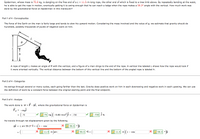
Elements Of Electromagnetics
7th Edition
ISBN: 9780190698614
Author: Sadiku, Matthew N. O.
Publisher: Oxford University Press
expand_more
expand_more
format_list_bulleted
Concept explainers
Question
why is it "1-cosx"? (underlined in red)

Transcribed Image Text:Spiderman, whose mass is 75.0 kg, is dangling on the free end of a L = 11.5-m-long rope, the other end of which is fixed to a tree limb above. By repeatedly bending at the waist,
he is able to get the rope in motion, eventually getting it to swing enough that he can reach a ledge when the rope makes a 59.3° angle with the vertical. How much work was
done by the gravitational force on Spiderman in this maneuver?
Part 1 of 4 - Conceptualize
The force of the Earth on the man is fairly large and tends to slow his upward motion. Considering the mass involved and the value of q, we estimate that gravity should do
hundreds, possibly thousands of joules of negative work on him.
A rope of length L makes an angle of 0 with the vertical, and a figure of a man clings to the end of the rope. A vertical line labeled L shows how the rope would look if
it were oriented vertically. The vertical distance between the bottom of this vertical line and the bottom of the angled rope is labeled h.
Part 2 of 4 - Categorize
He swings through several or many cycles, each going farther than the last. Gravity does positive work on him in each downswing and negative work in each upswing. we can use
the definition of work by a constant force between the original starting point and the final endpoint.
Part 3 of 4 - Analyze
The work done is W = F· Ar, where the gravitational force on Spiderman is
F, = -mg)
| 75 kg)
-9.80 m/s2 )j =
= -735
-735 jN.
75
He travels through net displacement given by the following.
Ar = L sin 59.3° î +
1- cos
59.3 •
11.5 m)sin
59.3 oî +
11.5 m)(1
59.3 •i
- cos
Expert Solution
This question has been solved!
Explore an expertly crafted, step-by-step solution for a thorough understanding of key concepts.
This is a popular solution
Trending nowThis is a popular solution!
Step by stepSolved in 4 steps with 1 images

Knowledge Booster
Learn more about
Need a deep-dive on the concept behind this application? Look no further. Learn more about this topic, mechanical-engineering and related others by exploring similar questions and additional content below.Similar questions
Recommended textbooks for you
 Elements Of ElectromagneticsMechanical EngineeringISBN:9780190698614Author:Sadiku, Matthew N. O.Publisher:Oxford University Press
Elements Of ElectromagneticsMechanical EngineeringISBN:9780190698614Author:Sadiku, Matthew N. O.Publisher:Oxford University Press Mechanics of Materials (10th Edition)Mechanical EngineeringISBN:9780134319650Author:Russell C. HibbelerPublisher:PEARSON
Mechanics of Materials (10th Edition)Mechanical EngineeringISBN:9780134319650Author:Russell C. HibbelerPublisher:PEARSON Thermodynamics: An Engineering ApproachMechanical EngineeringISBN:9781259822674Author:Yunus A. Cengel Dr., Michael A. BolesPublisher:McGraw-Hill Education
Thermodynamics: An Engineering ApproachMechanical EngineeringISBN:9781259822674Author:Yunus A. Cengel Dr., Michael A. BolesPublisher:McGraw-Hill Education Control Systems EngineeringMechanical EngineeringISBN:9781118170519Author:Norman S. NisePublisher:WILEY
Control Systems EngineeringMechanical EngineeringISBN:9781118170519Author:Norman S. NisePublisher:WILEY Mechanics of Materials (MindTap Course List)Mechanical EngineeringISBN:9781337093347Author:Barry J. Goodno, James M. GerePublisher:Cengage Learning
Mechanics of Materials (MindTap Course List)Mechanical EngineeringISBN:9781337093347Author:Barry J. Goodno, James M. GerePublisher:Cengage Learning Engineering Mechanics: StaticsMechanical EngineeringISBN:9781118807330Author:James L. Meriam, L. G. Kraige, J. N. BoltonPublisher:WILEY
Engineering Mechanics: StaticsMechanical EngineeringISBN:9781118807330Author:James L. Meriam, L. G. Kraige, J. N. BoltonPublisher:WILEY

Elements Of Electromagnetics
Mechanical Engineering
ISBN:9780190698614
Author:Sadiku, Matthew N. O.
Publisher:Oxford University Press

Mechanics of Materials (10th Edition)
Mechanical Engineering
ISBN:9780134319650
Author:Russell C. Hibbeler
Publisher:PEARSON

Thermodynamics: An Engineering Approach
Mechanical Engineering
ISBN:9781259822674
Author:Yunus A. Cengel Dr., Michael A. Boles
Publisher:McGraw-Hill Education

Control Systems Engineering
Mechanical Engineering
ISBN:9781118170519
Author:Norman S. Nise
Publisher:WILEY

Mechanics of Materials (MindTap Course List)
Mechanical Engineering
ISBN:9781337093347
Author:Barry J. Goodno, James M. Gere
Publisher:Cengage Learning

Engineering Mechanics: Statics
Mechanical Engineering
ISBN:9781118807330
Author:James L. Meriam, L. G. Kraige, J. N. Bolton
Publisher:WILEY